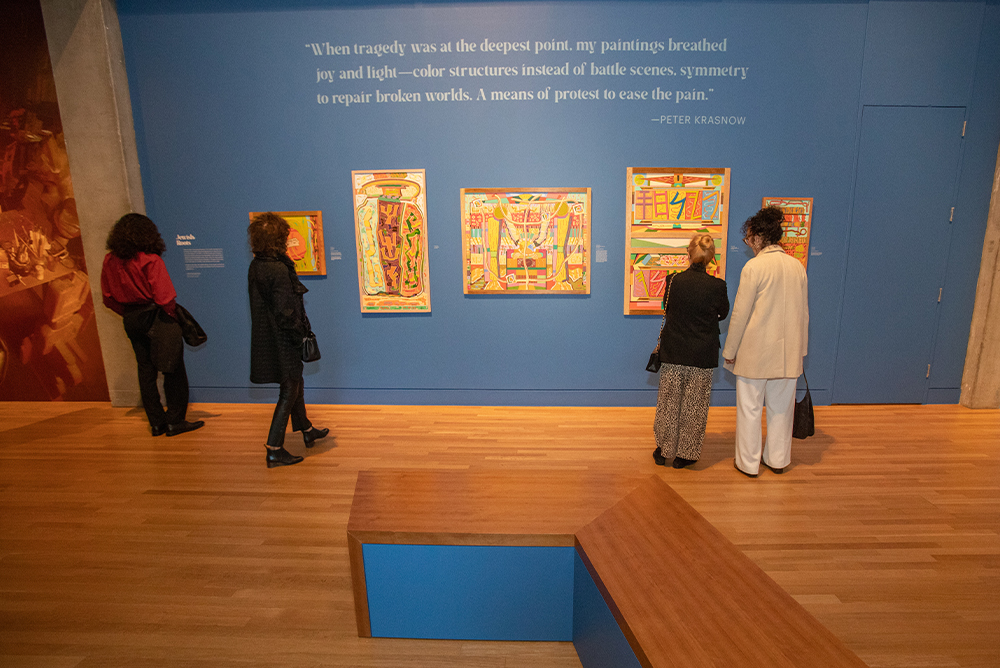
Artists shouldn’t have to be activists, writes Skirball Center CEO Jessie Kornberg. Krasnow Exhibition: The 2023 Skirball Cultural Center exhibition of “Peter Krasnow: Breathing Joy and Light.” Photo by Chris Hatcher Photography.
This piece publishes as part of the Zócalo, Thomas Mann House, and L.A. Review of Books conference on the role of artists in weakened democracies at REDCAT this Saturday. Register to join the in-person waitlist or to watch the livestream.
“Caring for myself is not self-indulgence, it is self-preservation, and that is an act of political warfare,” Audre Lorde wrote in A Burst of Light, 1988.
After 20 years of working and volunteering in a mixture of direct anti-poverty services, Jewish community organizations, and the arts, I find there is almost no situation that writer, poet, and civil rights activist Audre Lorde hadn’t already anticipated, considered, and conquered. At a moment of local, national, and international crises, when I consider the role I must play—and the space the organization I lead, Los Angeles’ Skirball Cultural Center, should occupy—I find reason and answer in Lorde’s indelible wisdom.
Lorde—who was Black and queer—lived the daily reality that her very being had been politicized, with or without her art and activism. This is the experience of many non-dominant artists and culturally specific institutions today: Your very existence is, apparently, political. You don’t have the luxury of deciding whether you are or are not an activist. You will be perceived as such, and as engaging in culture wars, regardless of your intention or action.
That assumption, and others that underlie it, are worth pushing back against. Especially right now.
I am not an artist, but as the head of a Jewish-identifying cultural institution, I have encountered such assumptions in small, largely innocuous, ways. I have been assumed to have a political agenda vis à vis Israel. I have encountered an assumption of progressive politics and feminism in my work. I have been assumed to work in the nonprofit sector to enjoy more time at home with my young children (ha!). And I have seen far more problematic instances of assumption and even aggression impact my colleagues of color, different cultural backgrounds, or minority sexual orientation.
It is infuriating to be reduced to one aspect of myself, without regard to the merit of my whole person, or the effect of my demonstrable efforts. It makes me appreciate those moments when I do have the freedom to decide to engage in activism. Or not. What extraordinary luck of birth and circumstance to have the freedom to make art without political retribution. It seems to me that the least those of us with that privilege can do is attempt to extend that freedom to others. This includes the freedom to choose not to be an activist, or to choose what issues to address and when and how.
Many artists I have had the privilege to know stress that their work is in dialogue not just with external influences and influencers, but with the audience itself. For them, the art is completed in the reaction and response of its consumer. Activism is, by definition, intended to persuade. To force artists to engage with audiences as activists is to narrowly define what creative interaction can entail.
I know this because I am one such audience member. On bad days at the office—when the office was a homeless shelter, a street clinic, or a courtroom during my time as a civil rights lawyer—the artists who brought me comfort, joy, distraction, and ultimately resilience were those who took my mind off my work. Who reminded me of my humanity. I would sit as the sun set on the Temple of Dendur. I would rest beside Whistler’s “Symphony in Flesh Colour and Pink.” I would take a break from trial at the Irvine courthouse and have lunch in the Noguchi Garden. In each of these moments, the art felt just for me, no matter how many hundreds of other people were walking by. These scenes touched something in me. Not because of their subjects, much less the political context in which they were created, but because of the works’ aesthetics and mine.
Activism is inherently time-bound. To force artists to speak only of the here and now is surely to deprive them of their chance at timelessness. Their chance at connection to the as-yet unborn, whose needs we can hardly imagine, but might yet be healed centuries from now, by the art of today.
I think of Peter Krasnow, the Ukrainian refugee whose oil paintings we showcased in a collection spotlight at the Skirball this past spring. In response to the events of World War II and the Holocaust, he transformed his artistic style completely, moving to the abstract and a color palette of highlighter greens and bubble gum pinks. He explained in his autobiography that this was his personal therapeutic approach to the depression he experienced as war raged and his family and homeland were annihilated. Seventy years later, his work not only feels current, but his clutching for beauty and light in a period of overwhelming darkness is resilient and instructive. I saw visitors to this show smile, cry, wonder aloud, point, decipher, get close, take a step back, and move forward.
Would we say to the Peter Krasnow of today, “No, your emotional expression, your desperate attempt to heal yourself, this is insufficient”? I hope not.




Send A Letter To the Editors